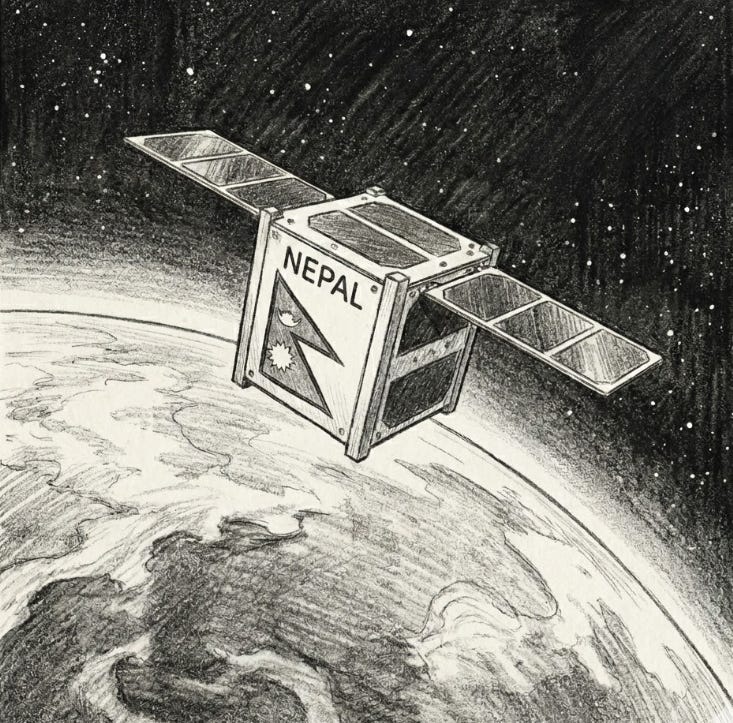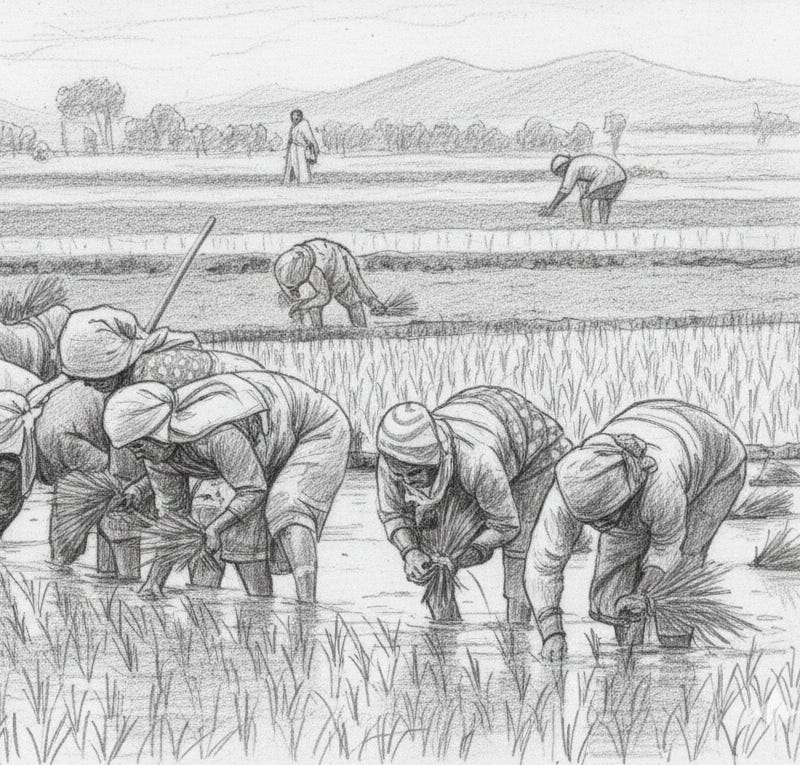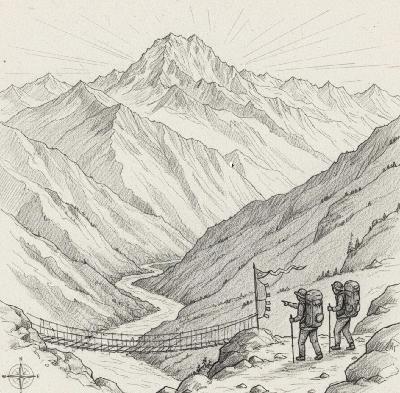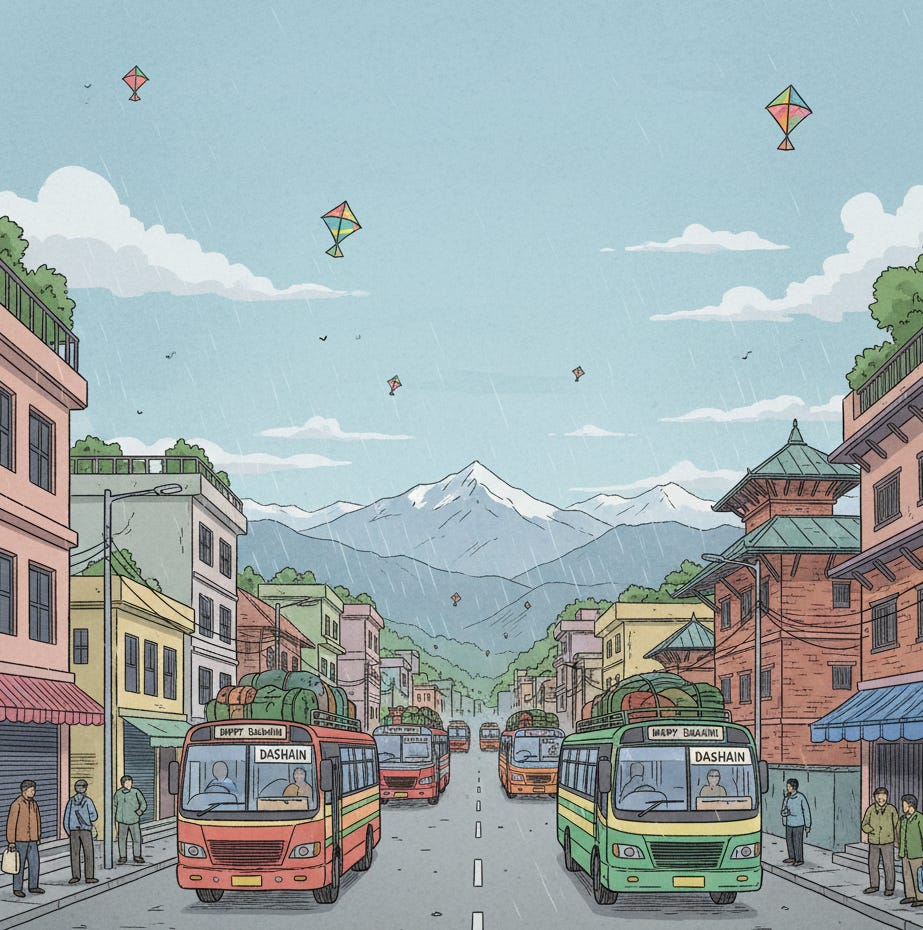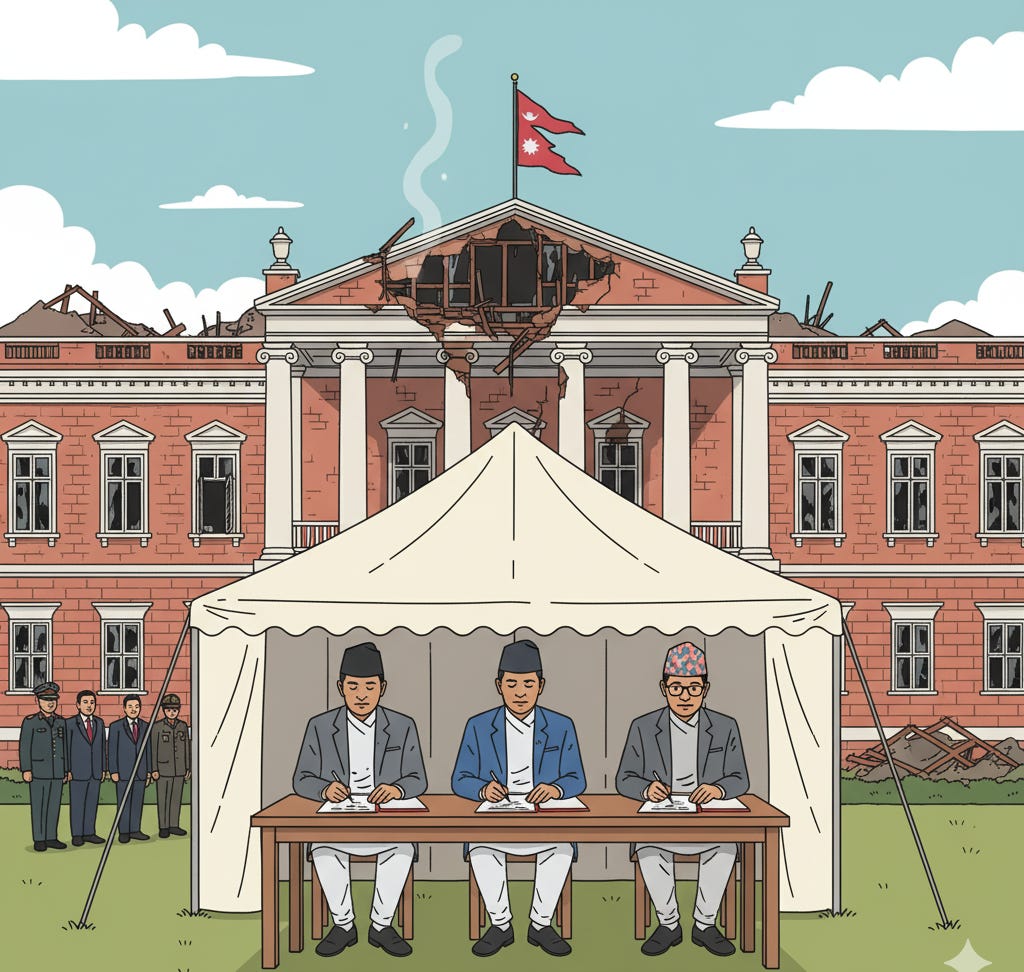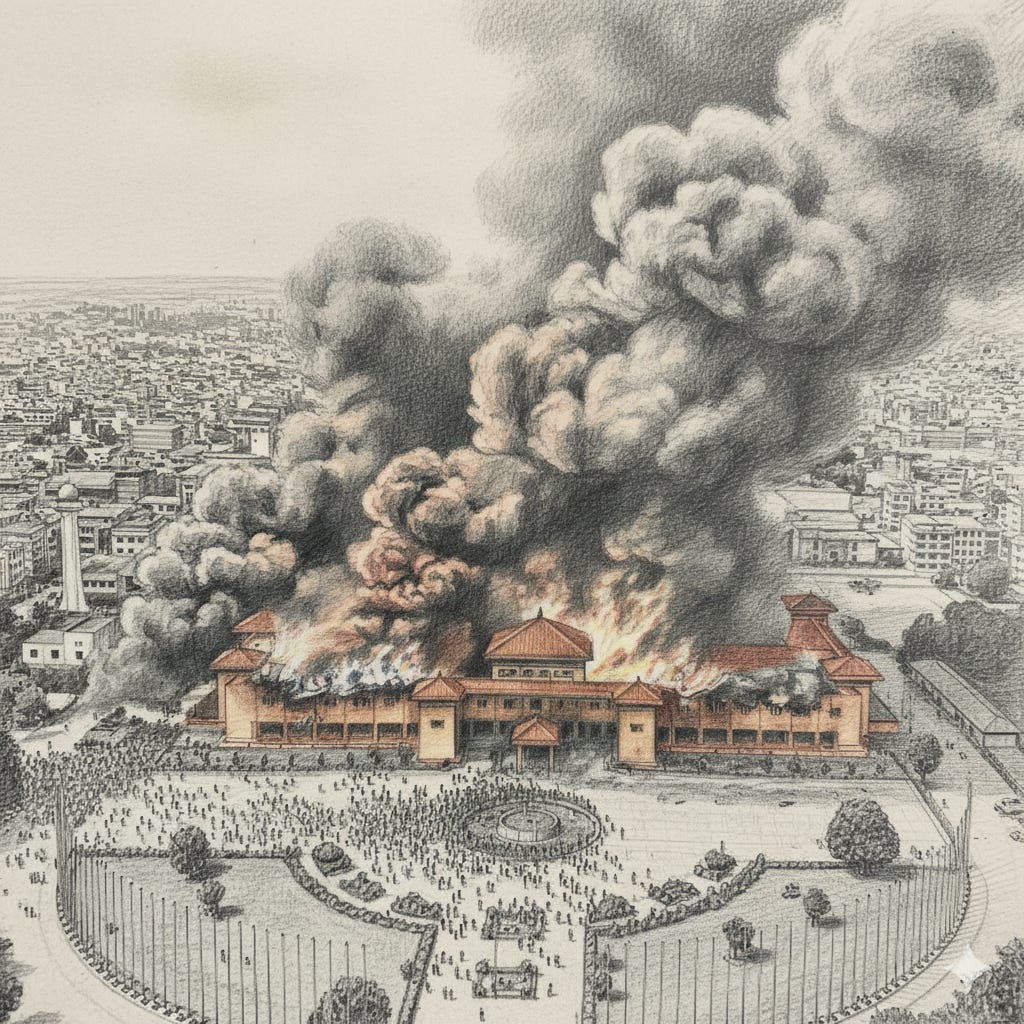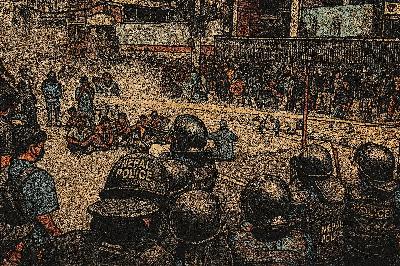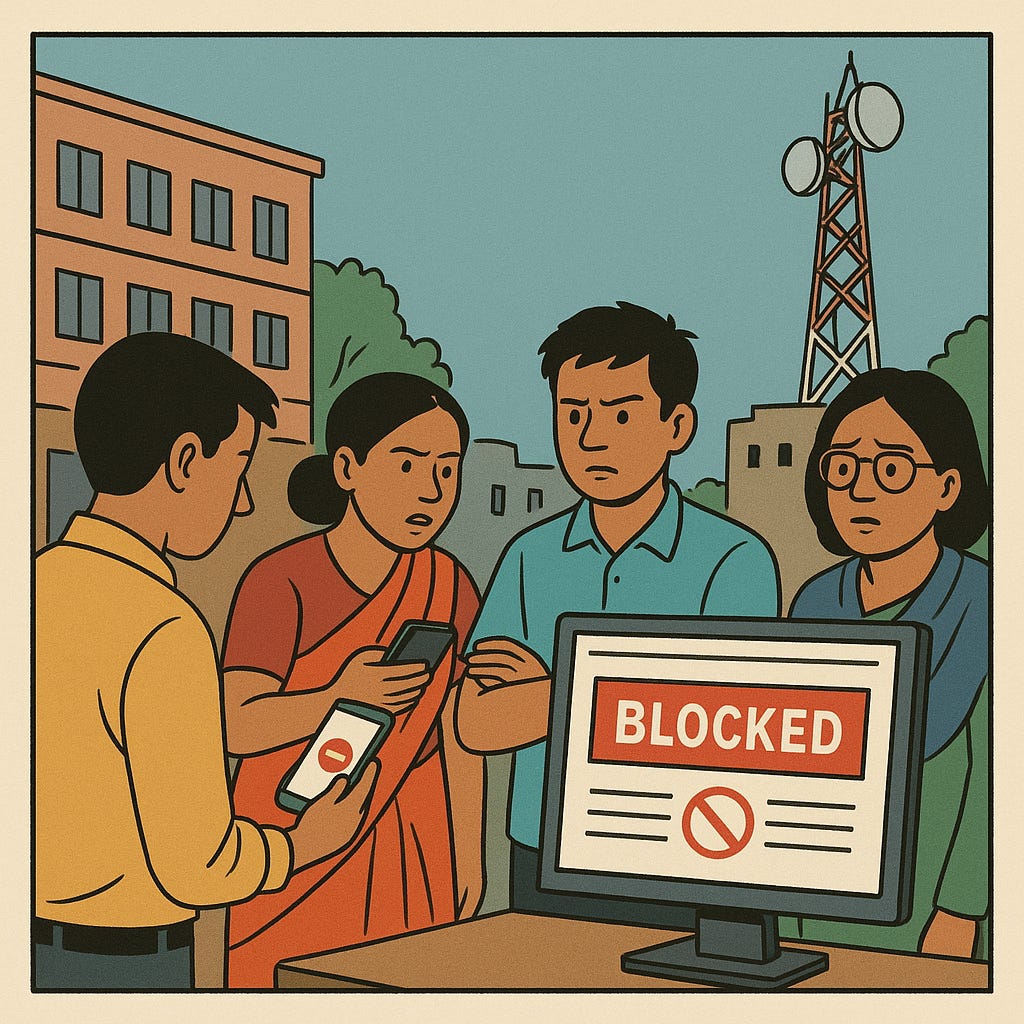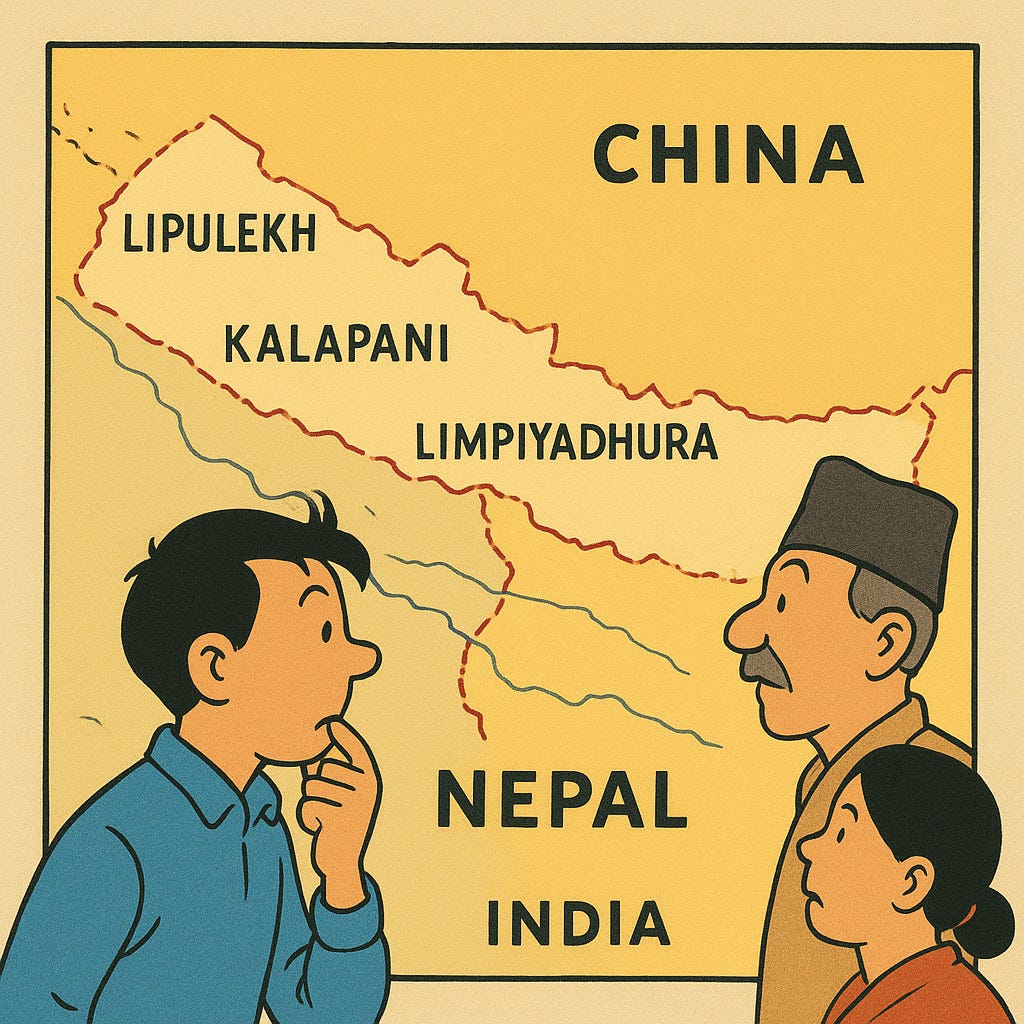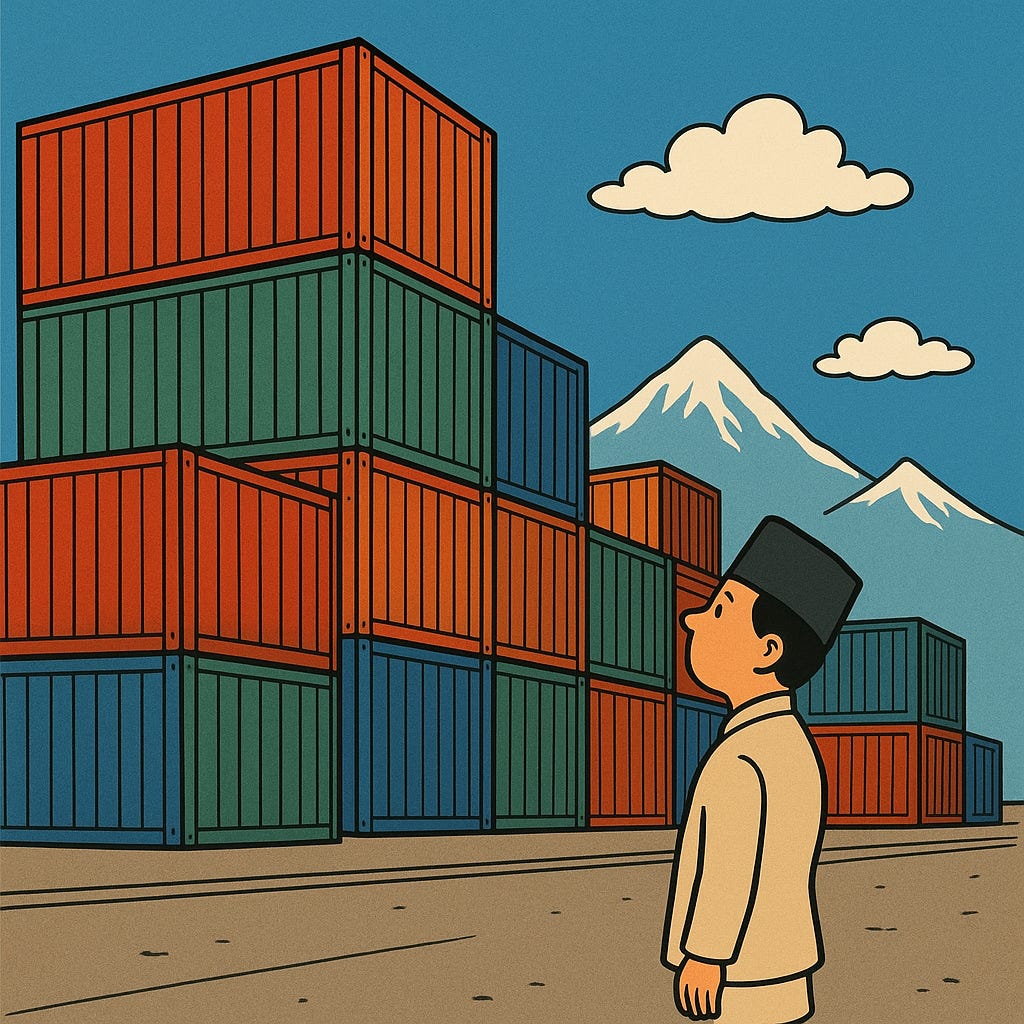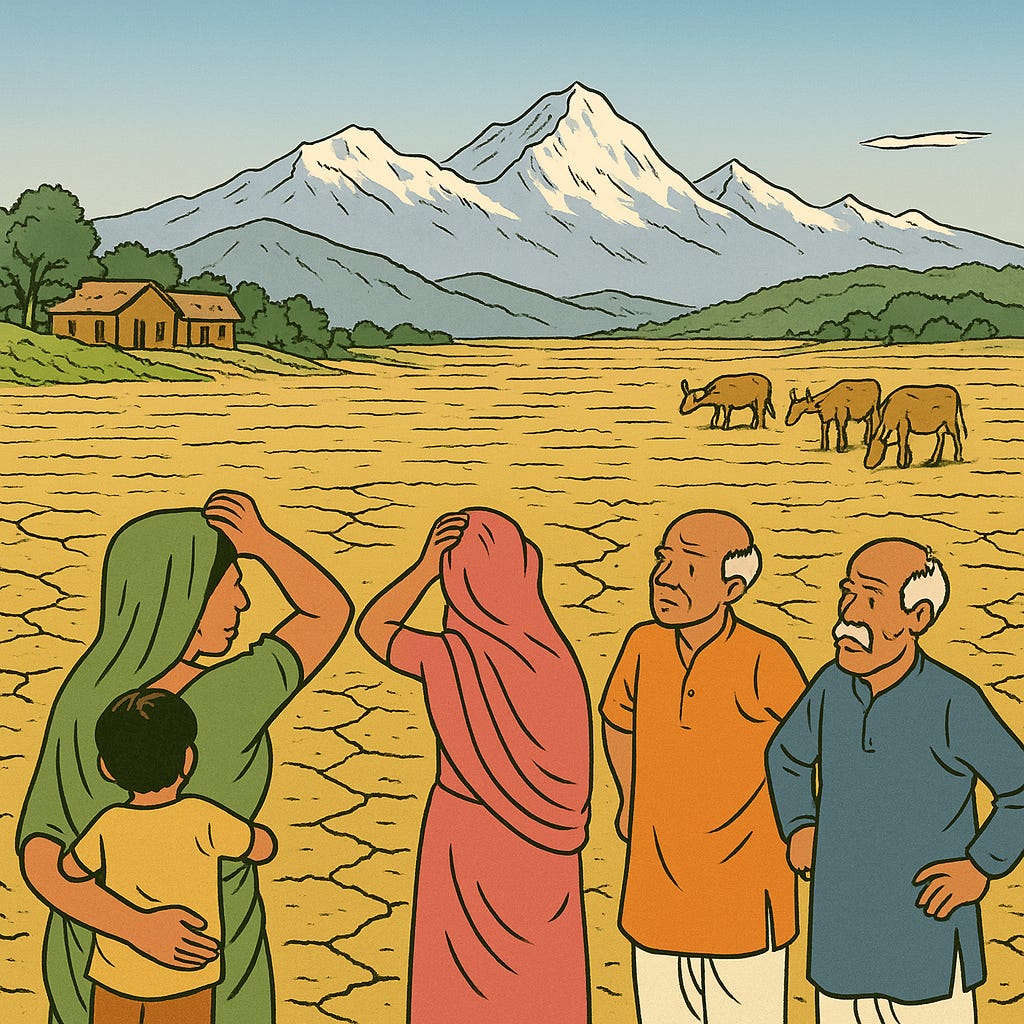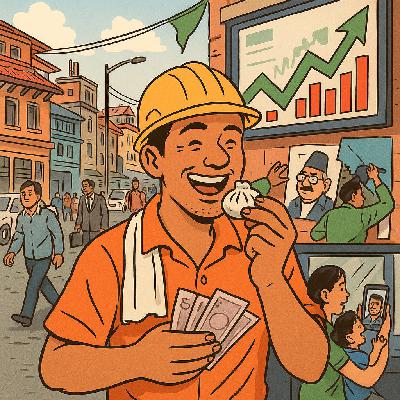Discover Nepal Diaspora Digest
Nepal Diaspora Digest

Nepal Diaspora Digest
Author: Your weekly dose of curated news, stories, and insights from Nepal and the global Nepali community—keeping you informed, inspired, and connected.
Subscribed: 2Played: 23Subscribe
Share
© Twakka ltd
Description
The Nepali Diaspora Digest is a written newsletter/blog and accompanying podcast which delivers the latest news, stories, and insights from Nepal and the global Nepali community. Hosted by our friendly, sometimes funny, and analytically sharp Nepal-AI agents, this weekly podcast keeps you updated on curated topics and headlines that matter—news, sports, lifestyle, and diaspora achievements. We monitor the news daily so you don’t have to, wrapping it all up in a 15-20 minute podcast and an accompanying newsletter to keep you connected, informed, and inspired—wherever you are.
www.nepalidiaspora.net
www.nepalidiaspora.net
46 Episodes
Reverse
Namaste! It has been a week of sharp contrasts for our global family. While we burst with pride seeing the Lumbini Lions clinch the NPL title and our wildlife conservation efforts making headlines, we are simultaneously rocked by anxiety over sudden shifts in US immigration policy. From the political corridors of Kathmandu where familiar faces solidify power, to the dense forests of Chitwan where tigers are being counted, this week has been anything but quiet. This is a public episode. If you would like to discuss this with other subscribers or get access to bonus episodes, visit www.nepalidiaspora.net
Namaste! It has been a week of profound contrasts for our global family. While we celebrate the resilience of the Lumbini Lions lifting the Nepal Premier League trophy and the inspiring ingenuity of Chepang students launching a satellite into space, we are also confronted with the grim reality of human trafficking in Myanmar. Politically, the government has signed a historic accord with the Gen Z movement to stabilize the streets, though the opposition remains vocal with massive rallies. Economically, there is a sigh of relief for travelers as the ban on high-value Indian currency is finally set to be lifted, even as national growth forecasts take a hit. Let’s dive into the stories defining our nation this week. This is a public episode. If you would like to discuss this with other subscribers or get access to bonus episodes, visit www.nepalidiaspora.net
As the winter chill settles in, Nepal warmed up this week with the vibrant celebrations of Yomari Punhi and Udhauli. While the Newar community feasted on steamed dumplings to mark the rice harvest and the Kirat community gathered to worship nature, the political and social spheres saw their own kind of “harvest.” From a long-awaited handshake unifying the Non-Resident Nepali Association (NRNA) to a sudden toppling of the provincial government in Madhesh, it’s been a week of resolving old conflicts and starting new chapters. Let’s dive in. This is a public episode. If you would like to discuss this with other subscribers or get access to bonus episodes, visit www.nepalidiaspora.net
This week, Nepal stands at a pivotal juncture, navigating a complex tapestry of national and global forces. Intense political dynamics are demanding a “political reset” as the nation prepares for crucial elections, while a powerful youth movement calls for deep-seated systemic transformation. Simultaneously, the welfare of Nepali migrant workers abroad takes center stage amid new fee structures and legal battles, underscoring critical human rights concerns. Amidst these internal discussions, Nepal is actively engaging on the international stage to promote its adventure tourism and strengthen economic ties, striving to balance progress with the preservation of its rich cultural heritage. This is a public episode. If you would like to discuss this with other subscribers or get access to bonus episodes, visit www.nepalidiaspora.net
While farmers are reeling from a devastating Rs 3.55 billion loss due to low rainfall—risking a projected 5% drop in paddy—Nepal's political landscape is making moves. PM Karki is championing the long-awaited right to diaspora voting, a historic step for Nepalis abroad. We navigate the complex week, from the political turmoil in Madhesh to the efforts to stabilize an economy strained by protests, all in your concise weekly digest. This is a public episode. If you would like to discuss this with other subscribers or get access to bonus episodes, visit www.nepalidiaspora.net
This week’s Nepal Digest reveals a nation actively navigating economic development, political shifts, and vibrant cultural preservation. Key highlights include South Korea’s initiative to open a visa center in Nepal and offer concessional loans to returnees, alongside the Nepali government’s strong push towards electrifying transport and cooking sectors to ensure 100% electricity access. Furthermore, the private sector is seeing renewed morale following government commitment to address concerns, while new transmission line projects promise energy independence. Meanwhile, Nepal’s rich cultural tapestry is being celebrated through temple constructions and traditional festivals, even as youth-led movements continue to engage with governance and accountability. Economic indicators like robust Social Security Fund deposits and rising export revenues underscore a resilient nation focused on growth and sustainable development amidst evolving challenges. Stay informed with these critical updates shaping Nepal’s future. This is a public episode. If you would like to discuss this with other subscribers or get access to bonus episodes, visit www.nepalidiaspora.net
The Nepali Diaspora Digest brings you the latest updates from Nepal and our global community. This week, we highlight the impressive recovery of the tourism sector in the Annapurna region and Pokhara, with significant tourist arrivals and high hotel occupancy rates. In politics, we delve into the continuing fallout from the Gen Z movement, crucial election preparations, and recent cabinet expansions. Culturally, we celebrate the vibrant Chhath festival, the historic Kartik Naach, and the achievements of Nepalis like Aishworya Shrestha, recognized as a UN Youth Leader, and cricketer Rohit Kumar Paudel. We also cover important health updates on dengue cases and ongoing efforts in conservation, rescue operations, and the release of new books exploring Nepali heritage. Stay informed about the key economic developments, from stock market fluctuations and gold price changes to significant infrastructure projects like the Sindhuli Road rehabilitation and new cross-border transmission lines between Nepal and India. This is a public episode. If you would like to discuss this with other subscribers or get access to bonus episodes, visit www.nepalidiaspora.net
As the lights of Tihar dimmed and families across Nepal bid farewell to the five-day festival of joy, this week asked us fundamental questions about who we are and who gets to belong. From heated debates over Tashi Lhazom’s “Nepali-ness” exposing the ugly fault lines of ethnic nationalism, to desperate migrants spending millions only to face deportation at America’s gates, to our athletes claiming silver medals on Spanish mountains and cricket victories that stunned the world—this edition captures a nation caught between fading festival lights and harsh political realities, between economic turbulence and infrastructure triumphs, between celebration and tragic loss. As Prime Minister Karki navigates fractured politics toward March elections, one truth emerges: Nepal’s resilience isn’t found in any single definition of identity, but in the collective strength of all its people, whether they’re running mountain trails, building bridges, or lighting butter lamps and hoping for better days ahead. This is a public episode. If you would like to discuss this with other subscribers or get access to bonus episodes, visit www.nepalidiaspora.net
Happy Tihar to all celebrating the festival of lights! As diyas glow and marigolds adorn homes across Nepal and the diaspora, this week carries the weight of profound loss and historic triumph. We grieve Bipin Joshi—the young hero who saved 17 lives before perishing in Gaza—even as we roar with pride for our cricket team’s unbeaten T20 World Cup qualification. Prime Minister Sushila Karki promises elections in six months while bringing Gen Z voices into government, steering Nepal through its most critical political moment in years. This Tihar, we light our lamps for those we’ve lost, celebrate wins that unite us, and look forward—together—to the brighter days ahead. This is a public episode. If you would like to discuss this with other subscribers or get access to bonus episodes, visit www.nepalidiaspora.net
Wishing a happy and joyous Dashain to everyone! It’s a time of family, feasting, and... political shake-ups? As Nepal navigates the aftermath of a youth revolution, the autumn season brings record tourists to the mountains, but landslides are making the journey home a challenge for some. Let’s dive into a week of big changes and celebrations! This is a public episode. If you would like to discuss this with other subscribers or get access to bonus episodes, visit www.nepalidiaspora.net
This week, Nepal navigates a pivotal moment of transition and turmoil. In Kathmandu, a new interim government begins the monumental task of rebuilding trust and ensuring accountability in the wake of the historic Gen-Z protests. This political shift unfolds as the entire nation embraces the spirit of its largest festival, Dashain, a celebration profoundly challenged by a nationwide landslide crisis that has brought travel to a standstill. The economic toll of the recent unrest is also coming into sharp focus, with staggering losses rattling the financial sector and leaving an already fragile economy at a critical crossroads. Meanwhile, stories of deep concern and significant progress for the Nepali diaspora unfold, from the ongoing plight of Bipin Joshi in Gaza to a landmark change in citizenship law. Here’s a deeper look at the key stories shaping Nepal this week. This is a public episode. If you would like to discuss this with other subscribers or get access to bonus episodes, visit www.nepalidiaspora.net
After a week that pushed the reset button on Nepali politics, a new technocratic government is rolling up its sleeves for the ultimate cleanup job. From rebuilding torched ministries to tracking down thousands of escaped prisoners, their to-do list is extensive. Yet, amidst the chaos, glimmers of normalcy are already appearing as life cautiously returns to the streets. Of course, the nation is also juggling everything else, from sudden dengue outbreaks to festival-disrupting landslides. Let's dive into a truly monumental week in Nepal!The New Government Takes ChargeIn the wake of a political vacuum, former Chief Justice Sushila Karki was appointed to lead an interim government, a move aimed at restoring stability after days of unprecedented turmoil. She swiftly appointed a small cabinet of widely respected technocrats, with Rameshore Khanal taking charge of the Ministry of Finance, Kulman Ghising being entrusted with the portfolios for Energy, Physical Infrastructure, and Urban Development, and anti-corruption activist Om Prakash Aryal appointed as Minister for Home Affairs and Law (THT). In a landmark decision, Senior Advocate Savita Bhandari Baral was also appointed as Nepal's first female Attorney General, signaling a new chapter for the country's legal and political landscape (MyRepublica).The selection of these ministers was widely seen as a direct response to the protestors' demands for proven competence and integrity. * Rameshore Khanal is a former Finance Secretary with over 30 years of experience, known for leading key reforms in government accounting and tax policy. In a powerful gesture of austerity, he announced he would not take a salary, official residence, or car for himself. * Kulman Ghising is an immensely popular public figure, celebrated for ending Nepal's chronic 18-hour-a-day power cuts during his previous tenure as head of the Nepal Electricity Authority. * Om Prakash Aryal is a prominent anti-corruption advocate known for his high-profile legal battles, including successfully filing a writ petition that led to the impeachment of a former chief of the anti-graft body, CIAA (Nepali Times).Stepping into their roles amidst a national crisis, the new ministers took immediate and decisive action. Finance Minister Khanal announced sweeping austerity measures, forming a task force to cut over 1,300 redundant projects and reallocate nearly Rs 100 billion to fund the upcoming election without foreign assistance (THT). Home Minister Aryal’s first decision was to declare a national day of mourning and provide financial relief to bereaved families. Minister Ghising began a multi-pronged effort, directing officials to manage the hundreds of burnt vehicles at Singha Durbar, to scrap contracts for long-neglected development projects, and to expedite the completion of the new Parliament building by December (MyRepublica).The international community responded swiftly, signaling crucial support for the new administration. Prime Minister Karki held a telephone conversation with Indian Prime Minister Narendra Modi, who conveyed condolences and reaffirmed India's steadfast support for restoring peace and stability (THT). The United States also voiced its backing, with Ambassador Dean R. Thompson meeting PM Karki to reiterate American support for Nepal's peaceful and democratic path forward, a sentiment echoed by the Chinese Ambassador in a separate courtesy call (THT).At home, the government faces a complex political landscape. The GenZ group that propelled Karki to power quickly voiced dissatisfaction with some ministerial choices and issued a list of demands, including the arrest of former officials, the formation of a high-level commission to investigate the wealth of leaders since 1990, and constitutional amendments for a directly elected Prime Minister (MyRepublica). Concurrently, the sidelined major political parties issued a joint statement denouncing the dissolution of Parliament as "undemocratic and unconstitutional" and demanding its immediate restoration, setting the stage for potential political friction (Nepali Times).In her first major public address on Constitution Day, Prime Minister Karki sought to bridge this divide, framing the GenZ movement not as an attack on democracy but as a "measure of the health of our democratic system" and a reflection of youth dissatisfaction with corruption and poor governance (TRN). She clarified that her role was for "interim management" with the sole purpose of holding elections within six months and handing over power to a newly elected government, calling on all sides to unite for the great campaign of reconstruction (Nepali Times).A Nation in RecoveryBefore any rebuilding could begin, the nation paused to confront the profound human cost of the unrest. The new government’s first act was to officially declare those killed as martyrs, a deeply symbolic gesture to honor their sacrifice (THT). A national day of mourning was observed, with flags flown at half-mast at government offices and Nepali missions abroad. Across the country, citizens from all walks of life gathered for solemn candlelight vigils at places like Maitighar Mandala, paying tribute to the 74 people who lost their lives and seeking solace in a moment of shared grief (THT).The economic toll of the destruction is staggering and widespread. The Hotel Association Nepal (HAN) reported preliminary losses exceeding Rs 25 billion, with dozens of properties vandalized in Kathmandu, Pokhara, Butwal and other cities, leaving over 2,000 workers jobless during the peak festive season (Annapurna Exp). Local governments also suffered catastrophic damage, with the Birgunj metropolis alone reporting losses of Rs 1.15 billion. The financial markets reflected the deep uncertainty, as the Nepal Stock Exchange (NEPSE) plummeted by 6% upon reopening, triggering three successive circuit breakers that halted all trading for the day (Onlinekhabar).Assessing the sheer scale of physical destruction is a monumental task. A preliminary study by the Nepal Engineers’ Association found that key government buildings, including the Supreme Court, are structurally unsound after severe fire damage, warning that the basement of the Kathmandu District Court was particularly critical after burning for 72 hours (Onlinekhabar). The devastation extended to the ministers' quarters in Bhanisepati, where 27 modern buildings were completely destroyed by arson. In a show of solidarity, the engineers' association has offered to provide free technical assistance for reconstruction nationwide, while some ministries have begun resuming work from temporary locations (THT).The path to recovery is severely complicated by an unprecedented security crisis. The nation's police force has been crippled, with over 218 police facilities in the Kathmandu Valley alone vandalized or burned, 117 police vehicles destroyed, and thousands of uniforms lost (MyRepublica). More alarmingly, protestors overran police armories, looting over 1,500 weapons, including SLRs and INSAS rifles. Former police officials have warned these weapons could be used in criminal activities, heightening public fear (Nepal News).Compounding the security threat is the mass escape of inmates from prisons across the country. The Department of Prison Management confirmed that out of nearly 14,000 inmates who broke out from 27 different jails, more than 8,800 fugitives remain at large. Many of these escapees were serving sentences for serious crimes such as rape, drug trafficking, and homicide (THT). Authorities have issued public notices and are coordinating with the Department of Immigration to track down the escapees, but the large number still unaccounted for poses a significant and ongoing risk to public safety (MyRepublica).Despite these immense challenges, concerted efforts to restore normalcy are yielding early results. Vital economic hubs like the Mechi Customs Office have resumed import-export services after staff procured new equipment (TRN). In districts like Jhapa and Chitwan, local governments are re-establishing police services in temporary buildings and urging transport entrepreneurs to resume operations. In a powerful symbol of resilience, Birgunj’s iconic Ghanta Ghar (clock tower) has been repaired and repainted, representing one of the first of many small but crucial steps on the long road to national recovery (Nepal News).Other DevelopmentsHealth authorities are battling multiple serious disease outbreaks. Gandaki Province has issued an alert for simultaneous outbreaks of dengue fever and a rare, vision-threatening eye infection known as Shapu (THT). On the infrastructure front, continuous rainfall triggered landslides that have blocked the Baglung section of the Kaligandaki Corridor, bringing traffic to a standstill (Khabarhub).The recent crisis was exacerbated by an "infodemic" of online misinformation that fueled public panic, highlighting a critical need for greater media literacy (Ktm Post). For Nepalis abroad, a new crisis emerged in Portugal, where immigration authorities began canceling residence permits of those alleged to have entered the country irregularly, creating fear and uncertainty within the community (Onlinekhabar).Let’s connectEnjoying this issue? 📩 Share it with a friend & let’s keep Nepalis worldwide in the loop! Got thoughts? Hit reply—we’re all ears! Or let us know what you think via our Feedback form or follow us on Facebook | LinkedInP.S. Got a story or issue you'd like us to cover next week? Drop us a reply — we're building this space together.About Nepali Diaspora Digest:The Nepali Diaspora Digest connects the global Nepali community with curated news, insights, and stories that matter most. Join us as we celebrate and explore the diverse voices and achievements of Nepalis worldwide.Partner shout outbelayat.uk: helping Nepalis connect in the UK on jobs, housing, events and finding local Nepali owned businesses This is a public episode. If you
Executive SummaryThe week of September 8, 2025, will be recorded as a watershed moment in Nepal's modern history. A digitally-native, youth-led movement against systemic corruption and state censorship escalated with breathtaking speed into a nationwide crisis that saw protests and violence erupt far beyond the capital, claiming over 50 lives, leading to the collapse of the government, and the dissolution of Parliament. What began as online dissent morphed into street protests, which then devolved into deadly clashes and widespread destruction, culminating in the appointment of an interim government led by former Chief Justice Sushila Karki, the nation's first female prime minister.This report provides a comprehensive analysis of the week's tumultuous events, charting the progression from peaceful protest to state violence and anarchic destruction. It examines the key actors, the political fallout, the severe economic and infrastructural damage, and the significant geopolitical implications for a nation strategically positioned between India and China. The week was a trial by fire for the Nepali state, revealing the profound power of a new generation while simultaneously exposing the fragility of its institutions and the immense challenges that lie ahead.The Spark That Ignited a Revolution: A Generation's ReckoningThe uprising was not a sudden eruption but the culmination of long-simmering public frustration. The immediate catalyst was the government's decision on September 7 to ban 26 widely-used social media platforms, including Facebook and Instagram citing a new law requiring local registration. For Nepal's youth, who relied on these platforms for communication, commerce, and expression, the move was seen as a blatant act of political censorship.This digital repression was the final breaking point for a generation that had already found its voice online through the viral "#Nepobaby" campaign. This hashtag was used to expose and condemn the extravagant lifestyles of the children of powerful politicians, which stood in stark contrast to the daily struggles of ordinary citizens. The trend was particularly fueled by viral footage of lavish events, such as the wedding of Foreign Minister Arzu Rana Deuba's son, which became a symbol of the disconnect between the ruling class and the populace. A day before the protests, then-Prime Minister KP Sharma Oli publicly mocked the "Gen Z" protesters as naive and easily led. Within 48 hours, he was an ex-Prime Minister.From Protest to Massacre: A Nation on FireOn September 8, the digital movement spilled onto the streets. An initially peaceful rally at Maitighar Mandala in Kathmandu drew an estimated 20,000 people, mostly students, before swelling into a massive demonstration outside Parliament. Protests also materialized across the country. Initial organizers urged non-violence, with many students attending in school uniforms in the belief it would afford them protection.However, the situation in the capital turned tragic when protesters broke through police barricades. Security forces responded with disproportionate and lethal force, deploying expired tear gas, water cannons, rubber bullets, and, according to eyewitnesses and international observers, live ammunition. The ensuing crackdown became a massacre, claiming the lives of at least 19 young protesters on the first day, with deaths reported in both Kathmandu and the eastern city of Itahari. This act of state violence drew immediate international condemnation from organizations like the UN Human Rights Office and triggered the resignation of the Home Minister.The events of September 9 saw the movement's initial discipline collapse into widespread chaos nationwide. Politically-motivated actors and opportunistic elements were blamed for hijacking the protests and instigating destruction on a massive scale.* Attacks on the Political Establishment: Public rage was directed squarely at prominent political figures. Mobs carried out physical attacks on senior leaders, including Nepali Congress President Sher Bahadur Deuba and his wife, Foreign Minister Arzu Rana Deuba. The private homes of other key figures, including CPN (Maoist Centre) chairman Pushpa Kamal Dahal, were also targeted.* Burning of Party Headquarters: In a symbolic assault on the entire political system, the central party headquarters of the three largest parties—the Nepali Congress, CPN-UML, and CPN (Maoist Centre)—were all set on fire and destroyed.* Destruction of State Symbols and Government Offices: The three pillars of the state were systematically targeted. In Kathmandu, arsonists set fire to the Parliament building, the Supreme Court, and the Singha Durbar administrative hub. This destruction was mirrored elsewhere, with government buildings in Pokhara, including the Gandaki Provincial Assembly, also being vandalized and burned.* Targeting of the Corporate Sector: The mob's fury expanded to the corporate world, targeting major business houses perceived to be part of a corrupt political-business nexus.* Chaudhary Group (CG): The country's largest multinational conglomerate, led by tycoon Binod Chaudhary, became a primary target. Arsonists destroyed its corporate headquarters and several automobile showrooms.* Bhatbhateni Supermarket Chain: Multiple outlets of the ubiquitous retail giant were systematically looted and set ablaze.* The Hotel and Tourism Sector: The industry faced a devastating assault, with around two dozen hotels damaged nationwide and losses estimated at over Rs 25 billion.* Other Key Sectors: The headquarters of Kantipur Publications, Nepal’s largest media house, was also set on fire.* Mass Prison Breaks: In a major security crisis, prisons across the country were stormed, leading to the escape of over 12,500 inmates and creating a nationwide security threat.By the end of the week, the official death toll from the unrest had risen to 51, including protesters, police, and inmates, with over 1,771 people treated for injuries.A Political Reckoning & An Interim SolutionOn September 12, after intense negotiations, a breakthrough deal was reached to appoint former Chief Justice Sushila Karki as interim Prime Minister, with a mandate to hold elections within six months. Her selection was a direct response to the protesters' demands for a non-partisan leader of unimpeachable integrity. Karki, Nepal's first female Chief Justice, built a formidable reputation as a firebrand judge with a zero-tolerance stance on corruption. Her career has been defined by landmark anti-graft rulings, including being part of the bench that convicted a sitting minister of corruption in 2012. In 2017, she famously weathered a politically motivated impeachment motion filed against her by the ruling coalition after she challenged their choice for police chief. The move was widely seen as an attempt to neutralize her, but it ultimately failed under public pressure, cementing her image as a figure unafraid to confront the political establishment. For the Gen-Z movement, her appointment therefore symbolized a genuine break from the very system they had risen up against.However, her appointment and the accompanying dissolution of Parliament were met with immediate dissatisfaction from the political establishment. The Nepali Congress, CPN-UML, and CPN (Maoist Centre) all expressed disapproval. This discontent was made powerfully evident by the notable absence of key political figures, including the outgoing Prime Minister and leaders of major parties, from Karki's oath-taking ceremony.Analysis: Dissecting the CrisisThe Dynamics of a Leaderless UprisingThe Gen-Z uprising was defined by its decentralized nature, which was both a source of strength and a critical vulnerability. It was a spontaneous convergence of public anger, adopting cultural symbols of rebellion from sources as varied as the Japanese anime One Piece.* Decentralized Mobilization: The movement was organic, mobilized through disparate social media groups. While the non-profit Hami Nepal was a visible initial organizer, it did not command the entire movement.* Vulnerability to Infiltration: The lack of a clear leadership structure made the protests susceptible to hijacking. As the initial rally turned violent, organizers quickly lost control, with politically-motivated actors and opportunists blamed for instigating the widespread arson and looting.* A Contested Mandate in Negotiations: In the power vacuum, a fractured anti-establishment front emerged. Figures like Hami Nepal's Sudan Gurung stepped into a negotiating role, a move criticized by other activists as unilateral. Simultaneously, popular independent figures like Kathmandu Mayor Balen Shah were considered potential prime ministerial candidates, highlighting the complex and competing interests at play.The War on Truth & The Specter of Foreign InfluenceThe physical violence was mirrored by a parallel war of information. Domestically, potent rumors of an impending military coup or a return of the ousted monarchy gained so much traction that the Nepali Army was forced to issue public denials. Beyond Nepal's borders, a more complex geopolitical conspiracy theory emerged, particularly in Western alternative media circles, questioning the organic nature of the uprising itself.The "Color Revolution" Theory: This perspective posits that the protests were not spontaneous, but a US-engineered "color revolution" designed to destabilize Nepal. Proponents point to alleged foreign funding of some organizing groups and the geopolitical motive of creating a strategic headache for both China and India. While this theory remains in the realm of conspiracy and lacks definitive proof, it raises an open question about the extent to which genuine domestic grievances can be amplified or exploited by external actors.The Scars of Upheaval: Economic and Infrastructural DamageThe week's violence inflicted what Chief Secretary Eknarayan Aryal called "massive and irreparable" da
Nepal is witnessing its deadliest youth-led movement since the democratic revolution of 2006. Long-standing frustrations over corruption, nepotism, and joblessness erupted after the government imposed a sweeping social media ban. Seen as censorship and an attempt to silence dissent, the ban ignited protests that have left at least 19 dead and more than 400 injured. Despite curfews, arrests, and police action, thousands of young Nepalis continue to take to the streets. Cabinet ministers have resigned, politicians’ homes have been targeted, and international attention has intensified. This is more than a protest—it is a generational call for change.This newsletter stands in solidarity with the Nepali youth, who have mobilized not for privilege or factional gain, but in pursuit of dignity, transparency, and a future free from systemic corruption.Causes and EscalationThe movement spread quickly across Kathmandu Valley and provincial capitals. For years, young Nepalis have endured corruption scandals, elite capture of opportunities, and limited job prospects. The tipping point came with the government’s sudden shutdown of Facebook, X, YouTube, and TikTok—platforms central to the social and civic lives of a generation raised online.Protests began peacefully, but security forces responded with batons, tear gas, and, ultimately, live fire.The Human TollThe crackdown has been devastating. At least 19 people have died—17 in Kathmandu and two in Itahari—while over 400 have sustained serious injuries. Hospitals overflowed with the wounded, and parents camped outside trauma centers searching for loved ones. Doctors worked around the clock as blood supplies ran low.These scenes have deeply affected the nation, highlighting the urgent need for accountability and reform.Government Accountability Under PressureThe political fallout has been immediate. Home Minister Ramesh Lekhak resigned on Monday, followed by Agriculture Minister Ramnath Adhikari on Tuesday, both citing the state’s handling of the protests. Opposition leaders, including Gagan Thapa of the Nepali Congress, have called for Prime Minister Oli to step down, arguing that the government has lost moral authority.Online, the hashtag #NepoKid has captured widespread frustration with a system where political dynasties hold power while ordinary youth face shrinking opportunities.Defiance Despite CurfewsAuthorities imposed curfews across Kathmandu, Lalitpur, Bhaktapur, and other provinces, banning movement, rallies, and gatherings. Yet protesters continued to assemble near the Parliament building in New Baneshwar, at Kalanki, and across towns nationwide—often carrying no banners, only their resolve. “Yesterday’s incident exposed the government’s failure. I came here to stand with the youths,” said one demonstrator.Curfews in Kavrepalanchok, Birgunj, Koshi Province, and the Far-West have not quelled the unrest.Targets of ResentmentProtesters have directed their anger at political leaders’ residences. The house of Minister Prithvi Subba Gurung was set on fire. Residences of Deputy Prime Minister Bishnu Paudel, former Home Minister Ramesh Lekhak, and central bank governor Biswo Paudel were stoned. Attempts were also made to reach the homes of former PM Sher Bahadur Deuba and CPN (Maoist Centre) chair Pushpa Kamal Dahal.Outside Kathmandu, provincial government offices and party headquarters have been vandalized, vehicles torched, and highways blocked.Condemnation at Home and AbroadThe violence has drawn international concern. Nine embassies—including the US, UK, Germany, France, Japan, South Korea, and Australia—issued a joint statement urging restraint. The UN human rights office and Nepal’s National Human Rights Commission called for independent investigations into excessive force.Domestically, outrage spans both ruling and opposition parties, with many acknowledging that the government’s repressive measures have deepened the crisis.Social Media Ban Lifted — But Trust ShatteredOn September 9, the government lifted the social media ban. Prime Minister Oli expressed regret, promised compensation to victims’ families, and announced a 15-day probe committee. Yet, for many young Nepalis, the damage is done. The ban may be gone, but trust in those who imposed it has been seriously eroded.A Generation That Cannot Be SilencedNepal’s youth have risked their lives to be heard. Their protests have forced resignations, challenged censorship, and captured international attention. The deaths of young Nepalis cannot be forgotten. The government now faces a choice: implement genuine reform and accountability, or continue facing growing demands from a generation determined to make its voice heard. History will judge whether it chooses dialogue or repression.Sources* The Kathmandu Post: Home Minister Ramesh Lekhak resigns — https://kathmandupost.com/national/2025/09/08/home-minister-ramesh-lekhak-resigns* The Kathmandu Post: Demand for blood rises in hospitals treating injured protesters — https://kathmandupost.com/national/2025/09/08/demand-for-blood-excessively-rises-in-hospitals-treating-injured-from-monday-s-protest* The Kathmandu Post: 19 dead in Gen Z protests — https://kathmandupost.com/national/2025/09/08/19-dead-in-gen-z-protests-across-nepal* The Kathmandu Post: Protesters attack leaders’ residences — https://kathmandupost.com/national/2025/09/09/protesters-attack-leaders-residences* The Kathmandu Post: Agriculture Minister Adhikari resigns — https://kathmandupost.com/national/2025/09/09/agriculture-minister-adhikari-resigns-over-gen-z-crackdown* The Kathmandu Post: Youths continue protests defying curfew orders — https://kathmandupost.com/national/2025/09/09/youths-continue-protests-defying-curfew-orders* The Himalayan Times: Gen Z protests intensify across Nepal — https://thehimalayantimes.com/nepal/gen-z-protests-escalate-across-nepal-multiple-curfews-injuries* The Himalayan Times: Nine embassies express concern over violence — https://thehimalayantimes.com/nepal/nine-embassies-express-concern-over-violence-and-fatalities-in-nepal* The Himalayan Times: Updated death toll and injuries — https://thehimalayantimes.com/kathmandu/updated-19-dead-over-300-injured-in-gen-z-protests-nationwide* My Republica: UN calls for transparent probe into killings — https://myrepublica.nagariknetwork.com/news/un-hr-body-calls-for-transparent-probe-into-protester-killings-in-nepal-13-36.html* My Republica: Health Ministry orders free treatment for injured — https://myrepublica.nagariknetwork.com/news/health-ministry-orders-free-treatment-for-injured-in-gen-z-protests-62-84.html* Reuters: Why is Nepal’s Gen Z protesting? — https://www.reuters.com/business/media-telecom/why-is-nepals-gen-z-protesting-2025-09-08/* Reuters: Nepal lifts social media ban after deadly protests — https://www.reuters.com/world/asia-pacific/nepal-lifts-social-media-ban-after-deadly-protests-2025-09-09/* Al Jazeera: Gen Z protests amid social media ban — https://www.aljazeera.com/news/2025/9/8/six-killed-in-nepal-amid-gen-z-protests-after-social-media-ban-all-to-know* BBC: At least 19 dead in Nepal after Gen Z protests — https://www.bbc.co.uk/news/articles/c78nd2zy9jgo* ITV News: Police open fire on protesters — https://www.itv.com/news/2025-09-08/police-in-nepal-open-fire-on-protesters-killing-multiple-demonstrators* The Times: Nepal protests leave 20 dead — https://www.thetimes.com/world/asia/article/nepal-protests-news-gen-z-social-media-tvn65rg6b* AP: Police open fire on protests over social media policy — https://apnews.com/article/nepal-protests-social-media-2025 This is a public episode. If you would like to discuss this with other subscribers or get access to bonus episodes, visit www.nepalidiaspora.net
Nepal served up a busy week: at home the government moved to block unregistered social platforms while abroad Prime Minister Oli walked a diplomatic tightrope in China—firm on Lipulekh yet eager to turn BRI talk into projects. Tourism is rebounding, US tariffs are nudging Indian garment makers to consider Nepal, a Dailekh gas find offers energy promise even as monsoon landslides highlight climate risk, and steady remittances keep the economy humming—so yes, Nepal is juggling apps, borders and a whiff of natural‑gas optimism. This is a public episode. If you would like to discuss this with other subscribers or get access to bonus episodes, visit www.nepalidiaspora.net
A high‑stakes diplomatic row over Lipulekh–Kalapani–Limpiyadhura has put Nepalese sovereignty and regional strategy center stage as India and China press ahead with border trade and infrastructure agreements. At home, the government is racing to modernise—rolling out a National AI Policy, expanding fibre and partnering with TikTok to boost tourism—while urgent Valley water‑safety alerts This is a public episode. If you would like to discuss this with other subscribers or get access to bonus episodes, visit www.nepalidiaspora.net
Trade bottlenecks, big‑ticket power contracts, and a dash of culture — Thangka provenance, cricket diplomacy, and yes, even methane finds — sum up this week in Nepal. With parliament dithering over dry‑port ratification and cabinet reshuffles while infrastructure deals, tourism tweaks and civic fixes promise practical gains, the diaspora should watch whether these moves turn into real momentum or just more political footwork. This is a public episode. If you would like to discuss this with other subscribers or get access to bonus episodes, visit www.nepalidiaspora.net
Nepal’s juggling a proud upgrade and a few pesky speed bumps this week — graduation from LDC status, fresh hydropower deals and infrastructure investments offer real upside, even as food‑import shocks, market jitters and price pain remind us the transition won’t be painless. We’re leading with a timely guest essay by Saurav Sharma — a diaspora‑focused playbook on turning a rare window of favourable conditions and sector openings into long‑term bets back home — because this issue is for Nepalis who want to act, not just watch. This is a public episode. If you would like to discuss this with other subscribers or get access to bonus episodes, visit www.nepalidiaspora.net
Trade booms and washed-out highways, AI debates and drought cries—Nepal's juggling act keeps us on our toes! While the Tarai thirsts for policy solutions and global diplomacy tests our principles, diaspora stars shine bright from Manila to Wall Street. Let's dive in! 🚀 This is a public episode. If you would like to discuss this with other subscribers or get access to bonus episodes, visit www.nepalidiaspora.net
Wage hikes, power plays, and mosquito drama—Nepal packed it all in this week. As salaries rise and political alliances fall, we’ve also got record stock trades, teenage football triumphs, and a bizarre dengue fix involving cement bans. Let’s dive into the madness, momentum, and maybe a bit of hope. This is a public episode. If you would like to discuss this with other subscribers or get access to bonus episodes, visit www.nepalidiaspora.net



